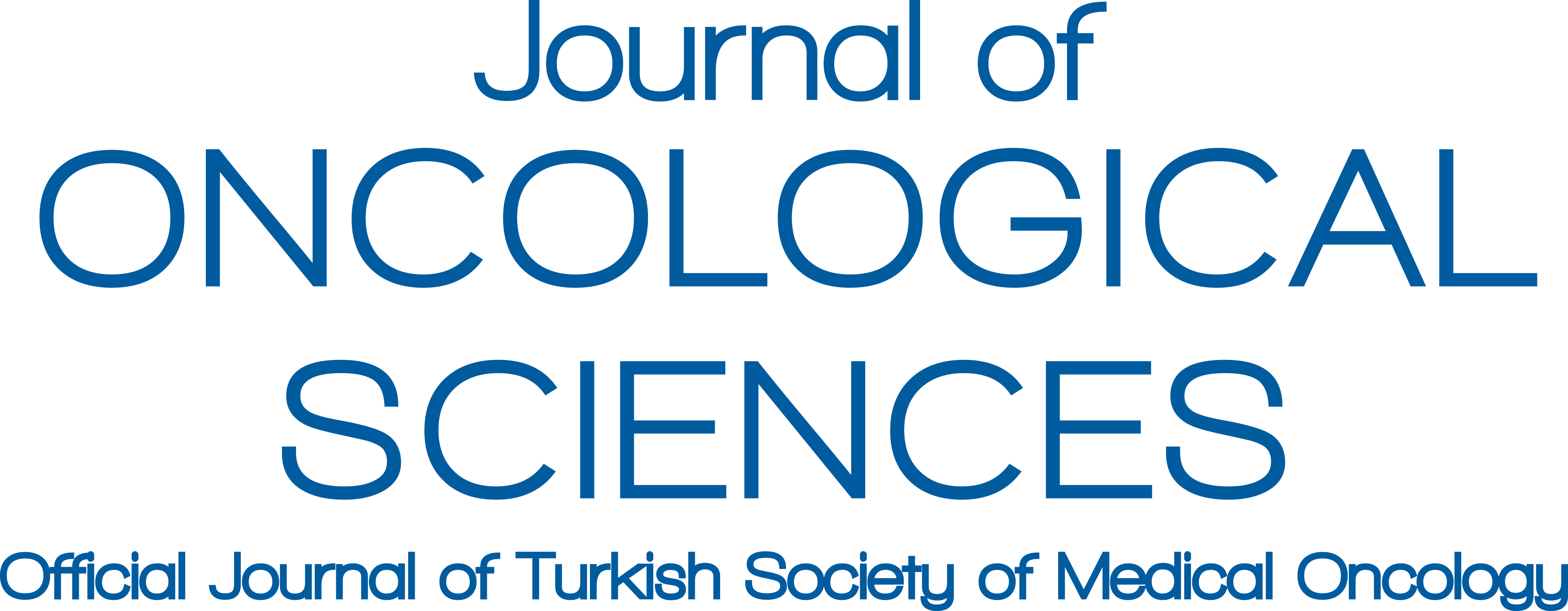Abstract
Objective: To elucidate the clinicopathological differences between breast cancer 1 (BRCA1) and BRCA2 carriers among patients
with breast carcinoma. Material and Methods: The present retrospective study explored the demographic and clinicopathological features
of 57 BRCA carriers with breast cancer. The age, family history, tumor Ki-67 index, tumor grade, hormone receptor status (estrogen and
progesterone), human epidermal growth factor receptor 2 status, tumor T and N Stage, tumor multifocality, and tumor treatment modalities
(surgical or adjuvant/neoadjuvant chemotherapy) were recorded for each patient from the hospital automation system. Results: The patients
with a median age of 39 (range: 23-68 years) years comprised 35% BRCA1 and 65% BRCA2 carriers. Higher median Ki-67 index was revealed
for the BRCA1 group than for the BRCA2 group (40% vs. 80%, p=0.006). The proportions of patients with estrogen receptor (+) and
progesterone receptor (+) tumors were 35.0% and 35.0%, respectively, in the BRCA1 group, whereas 75.7% and 73.0%, respectively, in the
BRCA2 group (p value 0.003 and 0.005, respectively). The BRCA1 group demonstrated significantly higher proportion of triple-negative patient
rate as compared to the BRCA2 group (21.6% vs. 55.0%, p=0.011). Multivariate logistic regression analysis conducted with the Ki-67
index, estrogen receptor status, progesterone receptor status, and triple-negative disease status identified the Ki-67 index as the only independent
predictive factor that could distinguish the BRCA1 from the BRCA2 mutation. A high Ki-67 index (>45%) was correlated with the
BRCA1 mutation (odds ratio: 0.970, 95% confidence interval: 0.943-0.999, p=0.044). Conclusion: A high Ki-67 index is more frequently
prevalent in BRCA1 carriers than in BRCA2 mutation carriers among patients with breast cancer.
Keywords:
BRCA1 protein, BRCA2 protein, breast, breast neoplasm
References
1Rojas K, Stuckey A. Breast cancer epidemiology and risk factors. Clin Obstet Gynecol. 2016;59(4):651-672.
2Brewer HR, Jones ME, Schoemaker MJ, Ashworth A, Swerdlow AJ. Family history and risk of breast cancer: an analysis accounting for family structure. Breast Cancer Res Treat. 2017;165(1):193-200.
3Demir S, Tozkir H, Gurkan H, et al. Genetic screening results of individuals with high risk BRCA-related breast/ovarian cancer in Trakya region of Turkey. J BUON. 2020;25(3):1337-1347.
4Lee A, Moon BI, Kim TH. BRCA1/BRCA2 pathogenic variant breast cancer: treatment and prevention strategies. Ann Lab Med. 2020;40(2):114-121.
5Duzkale N, Eyerci N. Double heterozygosity in the BRCA1/2 genes in a Turkish patient with bilateral breast cancer: a case report. Oncologie. 2020;22(3):161-166.
6Foulkes WD, Metcalfe K, Sun P, et al. Estrogen receptor status in BRCA1- and BRCA2-related breast cancer: the influence of age, grade, and histological type. Clin Cancer Res. 2004;10(6):2029-2034.
7Copson ER, Maishman TC, Tapper WJ, et al. Germline BRCA mutation and outcome in young-onset breast cancer (POSH): a prospective cohort study. Lancet Oncol. 2018; 19(2):169-180.
8Elston CW, Ellis IO. Pathological prognostic factors in breast cancer. I. The value of histological grade in breast cancer: experience from a large study with long-term follow-up. Histopathology. 1991;19(5):403-410.
9Loi M, Desideri I, Olmetto E, et al. BRCA mutation in breast cancer patients: Prognostic impact and implications on clinical management. Breast J. 2018;24(6):1019-1023.
10McCrorie AD, Ashfield S, Begley A, et al. Multifocal breast cancers are more prevalent in BRCA2 versus BRCA1 mutation carriers. J Pathol Clin Res. 2020;6(2):146-153.
11Hashmi AA, Hashmi KA, Irfan M, et al. Ki67 index in intrinsic breast cancer subtypes and its association with prognostic parameters. BMC Res Notes. 2019;12(1):605.
12Chen X, He C, Han D, et al. The predictive value of Ki-67 before neoadjuvant chemotherapy for breast cancer: a systematic review and meta-analysis. Future Oncol. 2017;13(9):843-857.
13Focke CM, Bürger H, van Diest PJ, et al; German Breast Screening Pathology Initiative. Interlaboratory variability of Ki67 staining in breast cancer. Eur J Cancer. October 2017; 84:219-227.
14Sønderstrup IMH, Jensen MR, Ejlertsen B, et al. Subtypes in BRCA-mutated breast cancer. Hum Pathol. February 2019;84:192-201.
15Parkes EE, Walker SM, Taggart LE, et al. Activation of STING-dependent innate immune signaling by S-phase-specific DNA damage in breast cancer. J Natl Cancer Inst. 2016; 109(1):djw199.
16Aydin F, Akagun T, Yildiz B, Fidan E, Ozdemir F, Kavgaci H. Clinicopathologic characteristics and BRCA-1/BRCA-2 mutations of Turkish patients with breast cancer. Bratisl Lek Listy. 2011;112(9):521-523.
17Bisgin A, Boga I, Yalav O, Sonmezler O, Tug Bozdogan S. BRCA mutation characteristics in a series of index cases of breast cancer selected independent of family history. Breast J. 2019;25(5):1029-1033.
18Atcı MM, Geredeli Ç, Ay S, et al. Clinical and pathological characteristics of patients with high-risk breast cancer based on BRCA mutation profiles: a retrospective study. Eur J Breast Health. 2021;17(2):123-127.



